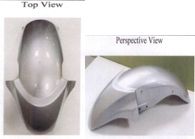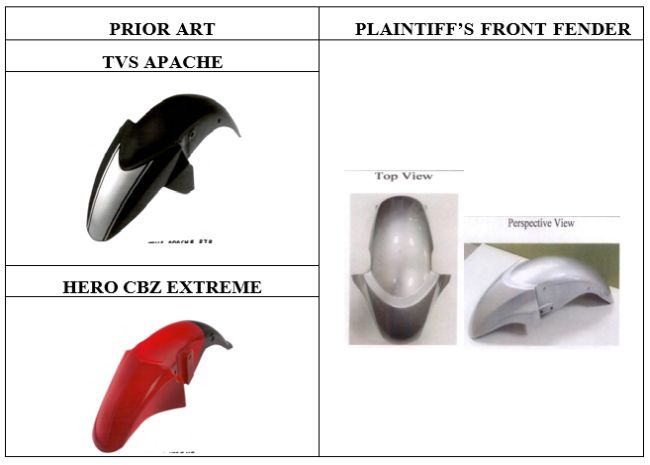On August 16, 2023, the Delhi High Court delivered a significant judgment in the case of Hero Motocorp Limited (herein after referred to as 'the plaintiff') versus Shree Amba Industries (herein after referred to as 'the defendant'), wherein it sheds light on the requirement for an article to have an independent life as an article of commerce and not be merely an adjunct of a larger article. This interpretation has significant implications for design protection and promotes innovation in the design industry.
Case Background:
The plaintiff filed the present suit seeking a permanent injunction against the defendant for infringing the registered design of their front fender. The plaintiff's registered design  , marked by a distinctive "V" shape and elevated surface on the front section, had been registered on April 7, 2015, under Registration No. 271199. The plaintiff argued that the defendant's front fender, marketed as "HF DLX TYPE," closely mimicked their registered design. They contended that the defendant's replication of their design constituted an act of piracy and dishonest infringement, leading to damage to their goodwill, reputation, and business. The plaintiff had also presented sales figures and advertising expenses as evidence of the popularity of their design, emphasizing its exclusivity.
, marked by a distinctive "V" shape and elevated surface on the front section, had been registered on April 7, 2015, under Registration No. 271199. The plaintiff argued that the defendant's front fender, marketed as "HF DLX TYPE," closely mimicked their registered design. They contended that the defendant's replication of their design constituted an act of piracy and dishonest infringement, leading to damage to their goodwill, reputation, and business. The plaintiff had also presented sales figures and advertising expenses as evidence of the popularity of their design, emphasizing its exclusivity.
In response, the defendant asserted that the plaintiff's registered design lacked novelty and originality, as it had been advertised in 2013 and 2014, prior to its registration in 2015. They also claimed that the design closely resembled the front fenders of earlier motorcycle models of the plaintiff, rendering it unremarkable. The defendant pointed out that other manufacturers had similar designs and highlighted that the plaintiff's design had functional aspects relating to airflow control rather than mere aesthetics. The defendant further argued that the plaintiff's claim that their front fenders were articles under the Designs Act was misplaced, as these fenders were replacement parts and not independent articles. They contended that the plaintiff's interpretation of "article" was overly broad and would impact the market for spare parts.
The plaintiff countered by asserting that their design was indeed novel and original. They emphasized on the defendant's intentional imitation and dishonesty, placing reliance on Midas Hygiene Industries Pvt. Ltd. versus Sudhir Bhatia & Ors., (2004) 3 SCC 90. The plaintiff also argued that the defendant's reliance on foreign patents and designs was inapplicable to the Indian context. In the rejoinder, the plaintiff emphasized the necessity of granting registration to parts intended to be sold separately, as indicated held by the Chancery Division in Sifam Electrical Instrument Company versus Sangamo Weston Limited, [1973] R.P.C. 899.
Court Analysis and Findings:
It is evident that the defendant's front fender is an identical replica of the plaintiff company's front fender. The defendant agreed that their fender is intended to serve as an exact substitute for the plaintiff company's motorcycle fender.
While considering various relevant judgements and legal principles, the Delhi High Court made a comparison between the defendant's prior art and the designs of front fenders from various brands already accessible in the market with the plaintiff company's registered design.

The Delhi High Court's analysis found that both designs mentioned by the defendant feature a distinctive 'V' shape on the front face of the fender, along with elongated sides. This resemblance is consistent with the actual "TVS Apache" design and the plaintiff company's design, both exhibiting the 'V' shape with extended sides. Minor differences in the 'V' shape among the various fenders are insignificant and can be considered as acceptable trade variations.
Moreover, the Delhi High Court noted that the "TVS Apache" design predates the plaintiff company's motorcycle launch by a significant number of years, supported by evidence from parts catalogs and invoices. This is important because prior publications like trade catalogues and depictions therein are considered as evidence of prior art. The plaintiff company's own models, such as "HERO CBZ EXTREME," have fenders with similar 'V' shape and elongated sides, preceding the "HERO HF DELUXE" model which features the plaintiff's current design.
Although the plaintiff argued that its design is not solely characterized by the 'V' shape and elongated sides, it was highlighted that the plaintiff itself described the design using these attributes in its claim. The Delhi High Court determined that the defendant's presented prior designs indeed incorporate these attributes. Additionally, when addressing the plaintiff's argument regarding restricted design freedom, the Delhi High Court stated that such limitations do not apply to fenders, as their functional requirements can lead to a range of designs.
The Delhi High Court concluded that the defendant has effectively contested the validity of the plaintiff company's design registration by presenting evidence of prior publications. Consequently, the plaintiff company has failed to establish a strong initial case for an interim injunction.
Furthermore, the Delhi High Court delved into the registrability aspect of the plaintiff's design under the Designs Act. The defendant contended that the front fender does not fall within the definition of "article" as outlined in Section 2(a) of the Designs Act. The Delhi High Court examined various precedents and legal principles to interpret the term "article" in the context of design infringement. It referred to the judgment of the House of Lords in Ford Motor Company, which held that for a spare part to qualify as an article, it must have an independent life as an article of commerce and not merely be an adjunct of a larger article. The Delhi High Court also considered the judgment of the Chancery Division in Sifam Electrical Instrument Company versus Sangamo Weston Limited, which emphasized that registration should be granted to parts of articles intended to be made and sold separately. It further discussed the judgment of the Division Bench of the Bombay High Court in Marico Limited versus. Raj Oil Mills, which held that the Indian definition of "article" includes a part of an article as well.
The Delhi High Court also addressed the argument that the Indian definition of "article" differs from the English definition. It disagreed with the view that there is a dissimilarity between the two definitions, stating that the Indian Designs Act's definition is pari materia with the English definition as interpreted by the House of Lords in Ford Motor Company. This alignment reinforces the importance of the independent commercial existence of a part in both jurisdictions.
In conclusion, the Delhi High Court's judgment in Hero Motocorp Limited versus Shree Amba Industries clarifies the interpretation of the term "article" in design infringement cases. By emphasizing the requirement for an article to have an independent life as an article of commerce, the court ensures that design protection extends to parts of articles that are intended to be made and sold separately. This interpretation promotes innovation, encourages investment in unique designs, and provides valuable guidance for designers and businesses seeking design protection.
The content of this article is intended to provide a general guide to the subject matter. Specialist advice should be sought about your specific circumstances.
 , marked by a distinctive "V" shape and elevated surface on the front section, had been registered on
, marked by a distinctive "V" shape and elevated surface on the front section, had been registered on 

